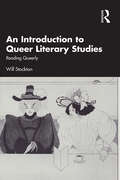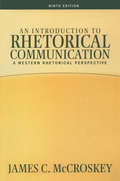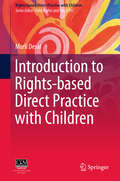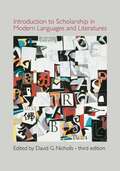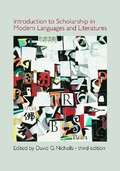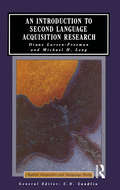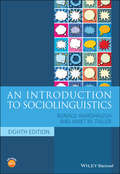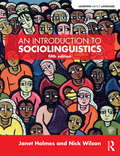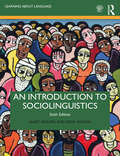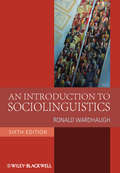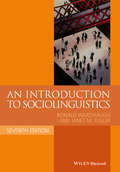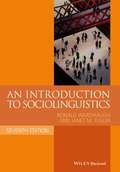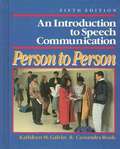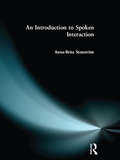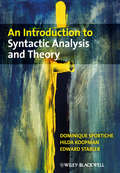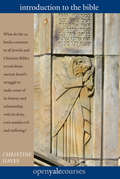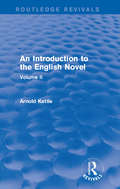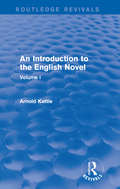- Table View
- List View
An Introduction to Queer Literary Studies: Reading Queerly
by Will StocktonAn Introduction to Queer Literary Studies: Reading Queerly is the first introduction to queer theory written especially for students of literature. Tracking the emergence of queer theory out of gay and lesbian studies, this book pays unique attention to how queer scholars have read some of the most well-known works in the English language. Organized thematically, this book explores queer theoretical treatments of sexual identity, gender and sexual norms and normativity, negativity and utopianism, economics and neoliberalism, and AIDS activism and disability. Each chapter expounds upon foundational works in queer theory by scholars including Michel Foucault, Eve Kosofsky Sedgwick, and Lee Edelman. Each chapter also offers readings of primary texts –ranging from the highly canonical, like John Milton’s Paradise Lost, to more contemporary works of popular fiction, like Stephen King’s ’Salem’s Lot. Along the way, An Introduction to Queer Literary Studies: Reading Queerly demonstrates how queer reading methods work alongside other methods like feminism, historicism, deconstruction, and psychoanalysis. By modelling queer readings, this book invites literature students to develop queer readings of their own. It also suggests that reading queerly is not simply a matter of reading work written by queer people. Queer reading attunes us to the queerness of even the most straightforward text.
Introduction to Rhetorical Communication
by James C MccroskeyAn Introduction to Rhetorical Communication offers a true integration of rhetorical theory and social science approaches to public communication. This highly successful text guides students through message planning and presentation in an easy step-by-step process. An Introduction to Rhetorical Communication provides students with a solid grounding in the rhetorical tradition and the basis for developing effective messages.
Introduction to Rights-based Direct Practice with Children
by Murli DesaiThe Sourcebook introduces the theoretical and ideological foundation and methodological basis of Rights-based Direct Practice with Children. It starts with the methodology of participatory group workshops to facilitate learning of the content. The content draws linkages among the foundation of life skills; psychosocial, sociological and critical theories of childhood; and child rights values, categories and principles; with the approaches, methods and skills of direct practice with children. The book takes examples from India but makes significant contribution to training and reference material for child rights teachers, trainers, facilitators and field workers, across the world, especially in the developing countries.
Introduction to Scholarship in Modern Languages and Literatures
by David G. NichollsThe third edition of the MLA's widely used Introduction to Scholarship in Modern Languages and Literatures features sixteen new essays by leading scholars. Designed to highlight relations among languages and forms of discourse, the volume is organized into three sections. "Understanding Language" provides an overview of the field of linguistics, with special attention to language acquisition and the social life of languages. "Forming Texts" offers tools for understanding how speakers and writers shape language; it examines scholarship in the distinct but interrelated fields of rhetoric, composition, and poetics. "Reading Literature and Culture" continues the work of the first two sections by introducing major areas of critical study. The nine essays in this section cover textual and historical scholarship; interpretation; comparative, cultural, and translation studies; and the interdisciplinary topics of gender, sexuality, race, and migrations (among others). As in previous volumes, an epilogue examines the role of the scholar in contemporary society.Each essay discusses the significance, underlying assumptions, and limits of an important field of inquiry; traces the historical development of its subject; introduces key terms; outlines modes of research now being pursued; postulates future developments; and provides a list of suggestions for further reading. This book will interest any member of the academic community seeking a review of recent scholarship, while it provides an indispensable resource for undergraduate and graduate students of modern languages and literatures.
Introduction to Scholarship in Modern Languages and Literatures (3rd edition)
by David NichollsThe third edition of the MLA's widely used Introduction to Scholarship in Modern Languages and Literatures features sixteen completely new essays by leading scholars. Designed to highlight relations among languages and forms of discourse, the volume is organized into three sections. "Understanding Language" provides a broad overview of the field of linguistics, with special attention to language acquisition and the social life of languages. "Forming Texts" offers tools for understanding how speakers and writers shape language; it examines scholarship in the distinct but interrelated fields of rhetoric, composition, and poetics. "Reading Literature and Culture" continues the work of the first two sections by introducing major areas of critical study. The nine essays in this section cover textual and historical scholarship; interpretation; comparative, cultural, and translation studies; and the interdisciplinary topics of gender, sexuality, race, and migrations (among others). As in previous volumes, an epilogue examines the role of the scholar in contemporary society.<P> Each essay discusses the significance, underlying assumptions, and limits of an important field of inquiry; traces the historical development of its subject; introduces key terms; outlines modes of research now being pursued; postulates future developments; and provides a list of suggestions for further reading. This book will interest any member of the scholarly community seeking a review of recent scholarship, while it provides an indispensable resource for undergraduate and graduate students of modern languages and literatures.
An Introduction to Second Language Acquisition Research (Applied Linguistics and Language Study)
by Diane Larsen-Freeman Michael H. LongUnderstanding how people learn and fail to learn second and foreign languages is increasingly recognised as a critical social and psycholinguistic issue. Second languages are vitally important to diverse groups of people, ranging from refugees to college students facing foreign language requirements. This book provides a synthesis of empirical findings on second and foreign language learning by children and adults, emphasising the design and execution of appropriate research.
An Introduction to Shakespeare
by Marchette ChuteFor children, a biography of William Shakespeare with very short synopses of his plays.
An Introduction to Sociolinguistics (Blackwell Textbooks in Linguistics)
by Janet M. Fuller Ronald WardhaughThe new edition of the most complete and student-friendly introduction to the field of sociolinguistics, fully revised and updated An Introduction to Sociolinguistics, Eighth Edition, is a broad overview of the study of language in social context, providing accessible coverage of major concepts, theories, methods, issues, and debates within the field. This leading textbook helps students develop a critical perspective on language in society as they explore the complex connections between societal norms and language use. Organized in four sections, the text covers traditional language issues, broad approaches to research in sociolinguistics, and language in relation to gender and sexuality, education, and policy. The eighth edition contains new and updated discussion of topics including the societal aspects of African American Vernacular English (AAVE), multilingual societies and discourse, gender and sexuality, ideologies and language attitudes, and the social meanings of linguistic forms. Fully updated throughout, this important textbook: Provides perspectives on both new and foundational research in sociolinguistics Features examples from a variety of languages and cultures that illustrate topics such as social and regional dialects, multilingualism, and language in education Includes end-of-chapter written exercises, key topic lists, chapter summaries, and “Explorations” designed to promote classroom discussion Offers students further reading suggestions, research ideas, and an updated companion website containing a searchable glossary, a review guide, additional exercises and examples, and links to online resources Includes a guide to the all explorations and exercises in the textbook, discussion topics, and other teaching resources via an instructor’s website Encouraging students to approach sociolinguistics both empirically and as a way of viewing the world around them, An Introduction to Sociolinguistics, Eighth Edition, remains the ideal textbook for upper-level undergraduate and graduate courses in sociolinguistics, language and society, anthropological linguistics, applied an
An Introduction to Sociolinguistics
by Janet HolmesSociolinguistics is the study of the interaction between language and society. In this classic introductory work, Janet Holmes examines the role of language in a variety of social contexts, considering both how language works and how it can be used to signal and interpret various aspects of social identity. Written with Holmes' customary enthusiasm, the book is divided into three sections which explain basic sociolinguistic concepts in the light of classic approaches as well as introducing more recent research. This fourth edition has been revised and updated throughout using key concepts and examples to guide the reader through this fascinating area, including: - New sections on: koines and koineisation linguistic landscapes New Englishes Stylisation language and sexuality societal approaches to attitude research forensic linguistics - A new selection of informative examples, exercises and maps -Fully updated further reading and references sections An Introduction to Sociolinguistics is an essential introductory text for all students of sociolinguistics and a splendid point of reference for students of applied linguistics. It is also an accessible guide for those who are simply interested in language and the many and varied uses we put it to.
An Introduction to Sociolinguistics
by Janet Holmes Nick WilsonIn this best-selling introductory textbook, Janet Holmes and Nick Wilson examine the role of language in a variety of social contexts, considering both how language works and how it can be used to signal and interpret various aspects of social identity. Divided into three sections, this book explains basic sociolinguistic concepts in the light of classic approaches as well as introducing more recent research. This fifth edition has been revised and updated throughout using key concepts and examples to guide the reader through this fascinating area, including: a new chapter on identity that reflects the latest research; a brand new companion website which is fully cross-referenced within this book, and which includes and video and audio materials, interactive activities and links to useful websites; updated and revised examples and exercises which include new material from Tanzania, Wales, Paraguay and Timor-Leste; fully updated further reading and references sections. An Introduction to Sociolinguistics is the essential introductory text for all students of sociolinguistics and a splendid point of reference for students of English language studies, linguistics and applied linguistics.
An Introduction to Sociolinguistics (Learning about Language)
by Janet Holmes Nick WilsonSociolinguistics is the study of the interaction between language and society. In this classic introductory work, Janet Holmes and Nick Wilson examine the role of language in a variety of social contexts, considering both how language works and how it can be used to signal and interpret various aspects of social identity. Divided into three parts, this book explains basic sociolinguistic concepts in the light of classic approaches, as well as introducing more recent research. This sixth edition has been revised and updated throughout, using key concepts and examples to guide the reader through this fascinating area, including: • New material on gender, social media and online use of language, code-switching, and language policy • An updated companion website that is fully cross-referenced within this book and featuring video and audio materials and links to useful websites. • Revised examples and exercises that will include new material from Asia and South America • Fully updated further reading and references sections. An Introduction to Sociolinguistics is an essential introductory text for all students of sociolinguistics and a splendid point of reference for students of English language studies, linguistics, and applied linguistics.
An Introduction to Sociolinguistics
by Ronald WardhaughThis comprehensive new edition of Wardhaugh's textbook incorporates additional study features and numerous new and updated references to bring the book completely up-to-date, whilst maintaining the features that made the book so popular with lecturers and students: accessible coverage of a wide range of issues, clearly written, and with useful student study features. A fully revised new edition of Ronald Wardhaugh's popular introduction to sociolinguistics, which now includes over 150 new and updated references and new study features throughout Features new "Explorations" sections in each chapter incorporating suggested readings, discussion sections, and exercises - all designed to encourage students to develop their own skills and ideas Reflects new developments in the field, providing greater focus on ideas such as identity, solidarity, and markedness Provides balanced coverage of a range of topics, including: language dialects, pidgins and Creoles, codes, bilingualism, speech communities, variation, words and culture, ethnographies, solidarity and politeness, talk and action, gender, disadvantage, and planning Comprehensive and accessible, it is the ideal introduction for students coming to sociolinguistics for the first time
An Introduction to Sociolinguistics (Blackwell Textbooks in Linguistics #16)
by Ronald Wardhaugh Janet M. FullerThoroughly updated and revised, An Introduction to Sociolinguistics, 7th Edition presents a comprehensive and fully updated introduction to the study of the relationship between language and society. Building on Ronald Wardhaugh’s classic text, co-author Janet Fuller has updated this seventh edition throughout with new discussions exploring language and communities, language and interaction, and sociolinguistic variation, as well as incorporating numerous new exercises and research ideas for today’s students. Taking account of new research from the field, the book explores exciting new perspectives drawn from linguistic anthropology, and includes new chapters on pragmatics, discourse analysis, and sociolinguistics and education. With an emphasis on using examples from languages and cultures around the world, chapters address topics including social and regional dialects, multilingualism, discourse and pragmatics, variation, language in education, and language policy and planning. A new companion website including a wealth of additional online material, as well as a glossary and a variety of new exercises and examples, helps further illuminate the ideas presented in the text. An Introduction to Sociolinguistics, 7th Edition continues to be the most indispensable and accessible introduction to the field of sociolinguistics for students in applied and theoretical linguistics, education, and anthropology.
An Introduction to Sociolinguistics (Seventh Edition)
by Ronald Wardhaugh Janet M. FullerThoroughly updated and revised, An Introduction to Sociolinguistics, 7th Edition presents a comprehensive and fully updated introduction to the study of the relationship between language and society. <p><p> Building on Ronald Wardhaugh’s classic text, co-author Janet Fuller has updated this seventh edition throughout with new discussions exploring language and communities, language and interaction, and sociolinguistic variation, as well as incorporating numerous new exercises and research ideas for today’s students. Taking account of new research from the field, the book explores exciting new perspectives drawn from linguistic anthropology, and includes new chapters on pragmatics, discourse analysis, and sociolinguistics and education. With an emphasis on using examples from languages and cultures around the world, chapters address topics including social and regional dialects, multilingualism, discourse and pragmatics, variation, language in education, and language policy and planning.
An Introduction to Speech Communication: Person to Person (5th edition)
by Kathleen M. Galvin Cassandra BookThis Fifth Edition comprises eight units and contains topics on communication such as The Communication Process and Inventories, Speaking and Listening, Self as Communicator, Interpersonal Communication, Group Communication, Public Communication, Persuasive Communication and Media Communication.
Introduction to Spoken Interaction, An
by Anna-Brita StenstromDescribes how conversation works, providing a systematic and exhaustive account of the structure of spoken discourse and the diverse strategies speakers use to have a conversation. It is illustrated throughout with excerpts from genuine conversation and contains numerous exercises with suggested answers based on conversations in the London-Lund Corpus of English Conversation.
An Introduction to Storytelling: By Storytellers from Around the World
by Christine WillisonWhere do stories come from, and how do we come to know them? Daughters listen with wonder to their grandmothers’ tales. Journalists have their trusted sources. Writers of storybooks draw unconsciously from the works of their predecessors. It is as if every story has within it an infallible truth, contained in the echo of its original telling. The storyteller recounts the tale. The listener hears, learns and remembers. In due course they will retell the same tale, adding in something of their own. And so listeners in time turn into storytellers. This inspiring book brings together the stories from across the world of listeners who themselves became storytellers. They reveal who influenced them the most, what drew them further in, what they learnt, and what they now wish to share with new generations. Tips, tools and tales: read this book, and take your turn.
Introduction to Strategic Public Relations: Digital, Global, and Socially Responsible Communication
by Janis Teruggi Page Lawrence J. ParnellHow can public relations play a more active role in the betterment of society? Introduction to Strategic Public Relations: Digital, Global, and Socially Responsible Communication prepares you for success in today’s fast-changing PR environment. Recognizing that developments in technology, business, and culture require a fresh approach, Janis T. Page and Lawrence Parnell have written a practical introductory text that aligns these shifts with the body of knowledge from which the discipline of public relations was built. Because the practice of public relations is rooted in credibility, the authors believe that you must become ethical and socially responsible communicators more concerned with building trust and respect with diverse communities than with creating throwaway content. The authors balance this approach with a focus on communication theory, history, process, and practice and on understanding how these apply to strategic public relations planning, as well as on learning how to create a believable and persuasive message. Key Features Chapter-opening Scenarios capture your attention by discussing current PR challenges—such as the Wells Fargo cross-selling, VW emissions cover-up, and P&G’s “Like a Girl” campaign—and thus frame the chapter content and encourage active reading. At the end of the chapter, you explore various aspects of socially responsible communication to “solve” the PR challenge. Socially Responsible Case Studies in each chapter illustrate the key responsibilities of a modern public relations professional such as media relations, crisis communications, employee communications, applied communications research, and corporate and government-specific communications. Each case features problem-solving questions to encourage critical thinking. Social Responsibility in Action boxes feature short, specific social responsibility cases—such as Universals’ #NoFoodWasted, Nespresso in South Sudan, and Merck’s collaboration with AIDS activists—to highlight best practices and effective tactics, showing the link between sound public relations strategy and meaningful social responsibility programs. Insight boxes spark classroom discussion on particularly important or unique topics in each chapter. Personality Profile boxes will inspire you with stories from PR veterans and rising stars such as the U.S. CEO of Burson-Marstellor, the Chief Communication Officer of the United Nations Foundation, and the Executive VP at HavasPR.
Introduction to Strategic Public Relations: Digital, Global, and Socially Responsible Communication
by Janis Teruggi Page Lawrence J. ParnellHow can public relations play a more active role in the betterment of society? Introduction to Strategic Public Relations: Digital, Global, and Socially Responsible Communication prepares you for success in today’s fast-changing PR environment. Recognizing that developments in technology, business, and culture require a fresh approach, Janis T. Page and Lawrence Parnell have written a practical introductory text that aligns these shifts with the body of knowledge from which the discipline of public relations was built. Because the practice of public relations is rooted in credibility, the authors believe that you must become ethical and socially responsible communicators more concerned with building trust and respect with diverse communities than with creating throwaway content. The authors balance this approach with a focus on communication theory, history, process, and practice and on understanding how these apply to strategic public relations planning, as well as on learning how to create a believable and persuasive message. Key Features Chapter-opening Scenarios capture your attention by discussing current PR challenges—such as the Wells Fargo cross-selling, VW emissions cover-up, and P&G’s “Like a Girl” campaign—and thus frame the chapter content and encourage active reading. At the end of the chapter, you explore various aspects of socially responsible communication to “solve” the PR challenge. Socially Responsible Case Studies in each chapter illustrate the key responsibilities of a modern public relations professional such as media relations, crisis communications, employee communications, applied communications research, and corporate and government-specific communications. Each case features problem-solving questions to encourage critical thinking. Social Responsibility in Action boxes feature short, specific social responsibility cases—such as Universals’ #NoFoodWasted, Nespresso in South Sudan, and Merck’s collaboration with AIDS activists—to highlight best practices and effective tactics, showing the link between sound public relations strategy and meaningful social responsibility programs. Insight boxes spark classroom discussion on particularly important or unique topics in each chapter. Personality Profile boxes will inspire you with stories from PR veterans and rising stars such as the U.S. CEO of Burson-Marstellor, the Chief Communication Officer of the United Nations Foundation, and the Executive VP at HavasPR.
An Introduction to Syntactic Analysis and Theory
by Dominique Sportiche Hilda Koopman Edward StablerAn Introduction to Syntactic Analysis and Theory offers beginning students a comprehensive overview of and introduction to our current understanding of the rules and principles that govern the syntax of natural languages. Includes numerous pedagogical features such as ‘practice’ boxes and sidebars, designed to facilitate understanding of both the ‘hows’ and the ‘whys’ of sentence structure Guides readers through syntactic and morphological structures in a progressive manner Takes the mystery out of one of the most crucial aspects of the workings of language – the principles and processes behind the structure of sentences Ideal for students with minimal knowledge of current syntactic research, it progresses in theoretical difficulty from basic ideas and theories to more complex and advanced, up to date concepts in syntactic theory
Introduction to the Bible
by Christine HayesThis book examines the small library of 24 books common to all Jewish and Christian Bibles—books that preserve the efforts of diverse writers over a span of many centuries to make sense of their personal experiences and those of their people, the ancient Israelites. Professor Christine Hayes guides her readers through the complexities of this polyphonous literature that has served as a foundational pillar of Western civilization, underscoring the variety and even disparities among the voices that speak in the biblical texts. Biblical authors wrote in many contexts and responded to a sweeping range of crises and questions concerning issues that were political, economic, historical, cultural, philosophical, religious, and moral. In probing chapters devoted to each of the 24 books of the Hebrew Bible, or Old Testament, Hayes reconstructs the meanings and messages of each book and encourages a deeper appreciation of the historical and cultural settings of ancient biblical literature.
An Introduction to the Blue Humanities
by Steve MentzAn Introduction to the Blue Humanities is the first textbook to explore the many ways humans engage with water, utilizing literary, cultural, historical, and theoretical connections and ecologies to introduce students to the history and theory of water-centric thinking. Comprised of multinational texts and materials, each chapter will provide readers with a range of primary and secondary sources, offering a fresh look at the major oceanic regions, saltwater and freshwater geographies, and the physical properties of water that characterize the Blue Humanities. Each chapter engages with carefully chosen primary texts, including frequently taught works such as Herman Melville’s Moby-Dick, Samuel Taylor Coleridge’s “Rime of the Ancient Mariner,” Homer’s Odyssey, and Luis Vaz de Camões’s Lusíads, to provide the perfect pedagogy for students to develop an understanding of the Blue Humanities chapter by chapter. Readers will gain insight into new trends in intellectual culture and the enduring history of humans thinking with and about water, ranging across the many coastlines of the World Ocean to Pacific clouds, Mediterranean lakes, Caribbean swamps, Arctic glaciers, Southern Ocean rainstorms, Atlantic groundwater, and Indian Ocean rivers. Providing new avenues for future thinking and investigation of the Blue Humanities, this volume will be ideal for both undergraduate and graduate courses engaging with the environmental humanities and oceanic literature.
An Introduction to the Celtic Languages (Longman Linguistics Library)
by Paul RussellThis text provides a single-volume, single-author general introduction to the Celtic languages.The first half of the book considers the historical background of the language group as a whole. There follows a discussion of the two main sub-groups of Celtic, Goidelic (comprising Irish, Scottish, Gaelic and Manx) and Brittonic (Welsh, Cornish and Breton) together with a detailed survey of one representative from each group, Irish and Welsh.The second half considers a range of linguistic features which are often regarded as characteristic of Celtic: spelling systems, mutations, verbal nouns and word order.
An Introduction to the English Novel: Volume II (Routledge Revivals: An Introduction to the English Novel)
by Arnold KettleFirst published in 1953, this book forms the second part of Arnold Kettle’s An Introduction to the English Novel. In this second part, Kettle builds a discussion of the modern English novel around the study of various books that have a more than casual significance in its development. He begins with an analysis of James, Hardy and Butler: three late Victorian writers whose work points forward to the major preoccupations of twentieth-century novelists. In his discussion of a dozen or so of these points, the author examines their progress in the long struggle of the novelist to see life steadily and whole, and points out some of the problems and hazards that beset the writer still. ‘The selection both of novelists and their work is excellent… it is both shrewd and witty…’ The Times Literary Supplement ‘Altogether this is a refreshing, challenging and original work, wholly adult in tone, and never pedantic or dull’ The Guardian
An Introduction to the English Novel: Volume I (Routledge Revivals: An Introduction to the English Novel)
by Arnold KettleFirst published in 1951 (this edition in 1967), this book forms the first part of Arnold Kettle’s An Introduction to the English Novel. Since the novel, like every other literary form, is a product of history, the book opens with a discussion of how and why the novel developed in England in the eighteenth century, as well as the function and background of prose fiction. The third part of the book examines six great novels from Jane Austen to George Eliot. ‘A serious and rewarding study.’ The Times Literary Supplement ‘His examination of some eighteenth century writers and analysis of six famous novels- from Emma to Middlemarch- have wit, authority and a sensitivity that compel the reader’s attention.’ Dublin Magazine
